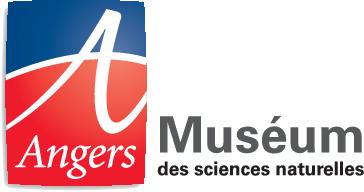
Natural Sciences Museum of Angers
Botany was developed in Angers with the foundation of the Association of Botanophiles in 1777, and sturdily established itself with the foundation of a Botanical Garden in 1789. The herbarium of the museum (350,000 collects) illustrates the work of the botanists who succeeded each other in Angers, and revolves around three significant collections: the general herbarium, of the herbarium of Alexandre Boreau (1803-1875), and the one of James Lloyd (1810-1896).
The core of the general herbarium is composed by the de Lens collection, a parisian botanist author of a flora of Paris in 1812. Donated in 1846, it mainly contains various collections that were revised over time: Lallemand, Bory de Saint-Vincent, Chaubard, Thuillier, Kunze, and several Centuries such as Unio Itineraria, and those of Sieber. Inside the parts of the herbarium, many discoveries were made: types from La Réunion Island collects by Commerson (travel to Bougainville), La Billardière (Entrecasteaux expedition), Poiteau (Saint Domingue), and even some rare samples from the 17th century.
The Alexandre Boreau herbarium was purchased by the municipality in 1875. It contains around 100,000 samples, that were used for the writing of the Flore du Centre de la France et du Bassin de la Loire, the most famous regional flora of its time. While still being inventoried, this herbarium reveals an important network of botanists and their correspondence (over 400), and an impressive number of types, generated by the “Jordanienne” approach of Boreau. For all these reasons, the Boreau herbarium earned its place in the French botanical history.
The herbarium of James Lloyd was bequeathed to the city in 1897, out of friendship to Boreau and Bastard. It is a huge herbarium (100,000 collects), that encompasses 24,000 species, that were used as a basis of reference for the Flore de l’Ouest de la France. This herbarium comes with Lloyd’s impressive library, and was made available to the public on September 15, 1898.
The other sets mostly inform on the departmental flora, even though they have samples from all over France. These sets include the herbaria of Georges Bouvet, Toussaint Bastard, Jean-Baptiste Guépin, and those of Ernest Préaubert. Around 50 small size sets compose the residual part of the city herbarium, with specimens from outside the city department: Corroy, Decluy, Duroux, Legros, or Giraudias for example.
There are also collections on specific taxa, which botanist took a late interest in: mosses (Bouvet, Bruneau), lichens (Decuillé, Thuillier), fungi (Gaillard, Guépin, Rabenhorst) or algae (Lloyd, Bory, Corillion). Despite this late interest, herbaria focusing on a single taxon are a rather common occurrence as one of the most important bathology collections in Europe (a Rubus herbarium, brambles) is kept in Angers.
The dry fruits and seeds herbaria encompass on one hand samples for educational purposes (about 1,000 french species, and 200 tropical species), and on the other hand, the Vilmorin collection of tree seeds from the early 20th century, which gathers collections from the National Museum and from Prince Bonaparte (about 1,100 samples).
The xylotheque, also composed by 2 collections, gathers collects of fallen trees in the Jardin des Plantes and the Allard Arboretum, and a collection of precious Guianese wood (1803).
Recent inventories highlight how associated documentation is critical for works based on collections. The library is also open to the public.
Contact
Thomas Rouillard : Thomas.rouillard@ville.angers.fr

Patrin Eugène, plants of Siberia, 1780. ©Muséum des Sciences Naturelles d’Angers

Precious wood ordered by Toussaint Bastard for the Jardin des Plantes of Angers in 1803.
©Muséum des Sciences Naturelles d’Angers

Lloyd James, Solieria chordalis, Morbihan, 1849.
©Muséum des Sciences Naturelles d’Angers